By Brad Steenrod
Why Your Red Dot Looks Blurry and What to Do About It
When you look through a red dot sight, do you see a crisp, clearly-defined reticle, or something completely different?

If you see a blurred dot that looks more like a star or a comma, or if you see multiple dots instead of one, you could have a defective optic or you may have an astigmatism.
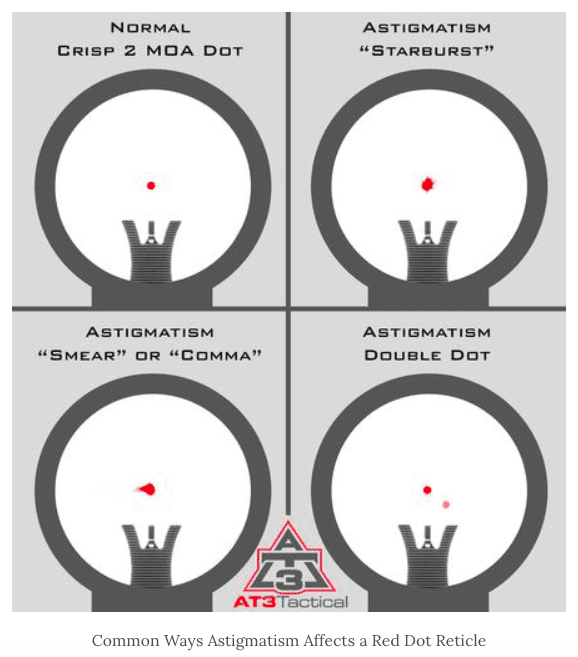
What is an astigmatism?
According to the American Academy of Ophthalmology, an astigmatism is an imperfection in the curvature of your cornea (the eye’s lens) that causes blurred or distorted vision. This isn’t just a problem for people with poor eyesight – you can have good overall vision and still have a mild astigmatism. In fact, LASIK surgery can create irregularities in the curvature of the cornea as well.

You may not even realize you even have an astigmatism until you first look through a red dot sight.
Diagnosing an Astigmatism vs. a Defective Red Dot

Of course, if your experience with a red dot has these kind of results, you’ll first want to confirm that it is indeed your eyes, and not a defective optic. There are a few different ways to do this:
- Turn on the optic, cover the front lens and take a picture of the dot. Does it appear the same way in the picture as it does when you look through the sight? A properly focused picture will show what the dot really looks like.
- Look at the dot through your backup iron sights. Is it still blurry and fuzzy?
When you look at the dot through your rear peep sight, it reduces the amount of light your eyes are taking in, allowing you to see the dot’s actual shape.
- While looking through the sight, line the dot up with an object, and then rotate the optic either clockwise or counterclockwise without moving the dot off target. If the issue is with the optic, the distorted image will move with the optic.
Once you have ruled out a faulty optic as the culprit, you should see an optometrist to find out more information on what is wrong with your vision and what you can do to correct it. If you already have vision issues, you can most likely get an updated prescription that corrects the astigmatism.
Working with What You Have

If you’ve bought red dot, there are a few things to try to see if it can work for you, despite your newly discovered vision issues. An astigmatism causes light to refract to multiple focal points in your eye, so reducing the amount of light going into your eye from the red dot minimizes the blurring effect.
You can:
- Use a lower brightness setting.
- Look “through” the dot and focus on the target instead of looking “at” the dot.
- Use your peep sight and red dot at the same time.
- Get corrective lenses for shooting.
- Wear polarized sunglasses.
If these tactics don’t work, you might wonder if you might have to just forego optics entirely. Fortunately, that isn’t necessary, and there are a few alternatives available for you to choose from:
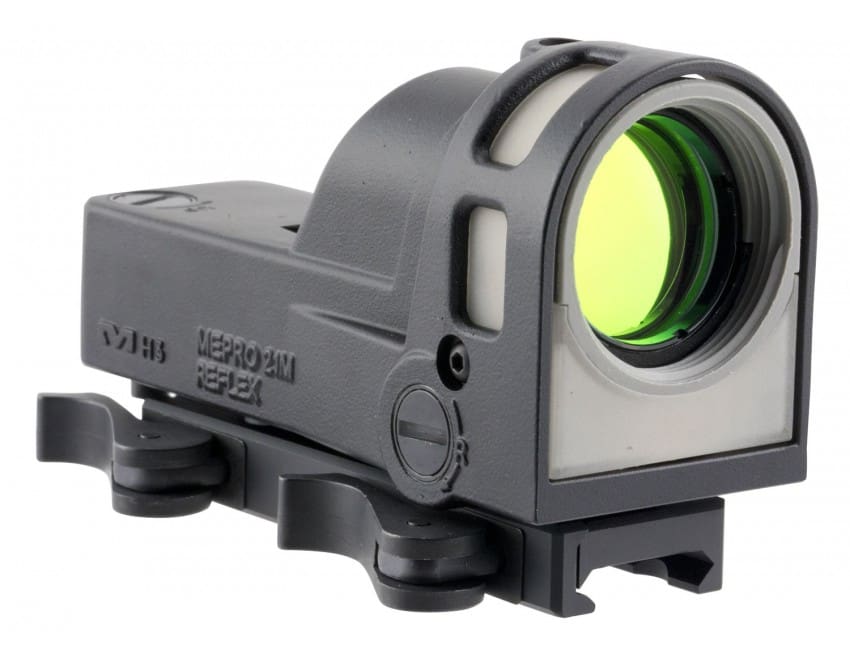
- A red dot with a larger MOA may be easier to see and have less distortion than a smaller MOA dot. This won’t eliminate the blur, but it may lessen the effect you experience while shooting. If you plan to try out this option, you will want to look for something with a reticle at least 4 MOA or larger.
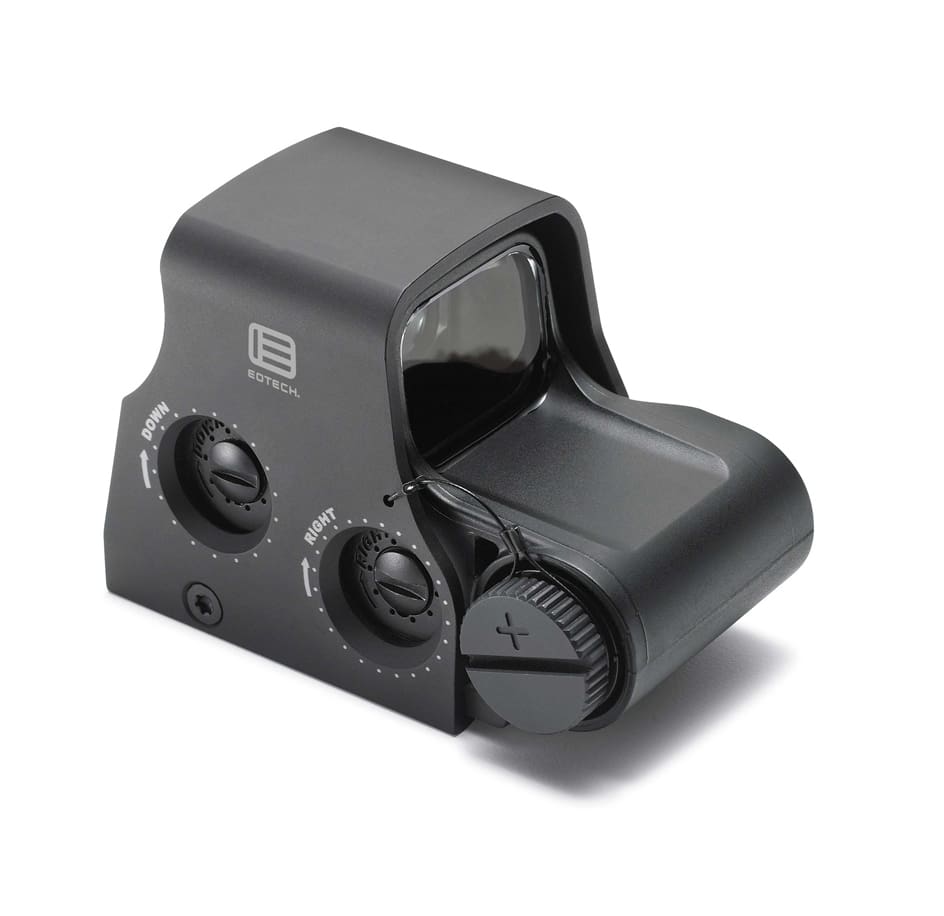
- A holographic sight bounces light off of a holographic grate to project light onto the lens. This acts like a polarizing filter, reducing the amount of light your eye is exposed to. Shooters with astigmatisms report a reduced amount of distortion when using holographic sights.
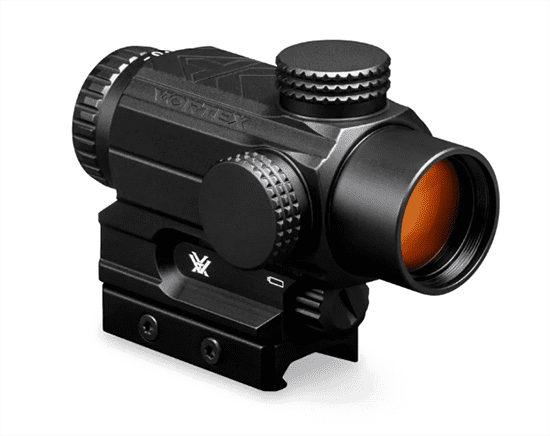
- A prismatic sight uses a lens and etched glass to produce its reticle, and functions more like a traditional rifle scope than a red dot. Many people with astigmatisms report fewer difficulties with these kinds of sights. They are offered in various magnification levels, but one with no magnification could be an ideal red dot replacement for a shooter with an astigmatism.
Having an astigmatism will not prevent you from enjoying electronic optics, but it may reduce which styles of optic will meet your needs.
If you have already bought a red dot sight, try out the tips mentioned above and see if it’s worth your while to keep.

If not, or if you haven’t already made a purchase, go down to your local gun shop and ask to see what the reticles look like for red dot sights of different MOAs, holographic sights, and prismatic sights. Doing this will help you quickly determine which sights will work for you right out of the box before spending your hard-earned money.
One Last Tip
If there’s anyone that knows the AR-15 platform, it’s the US military. As a special offer for our readers, you can get the Official US Army Manual for AR-15/M4/M16 right now – for free. Click here to snag a copy.
This article was originally published in AT3 Tactical AR Academy and is reprinted here with permission.


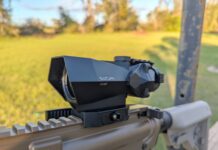


My optometrist corrects for astigmatism in my glasses, yet red dots still starburst.
I dont understand how lenses are corrected for it, but the dot still distorts.
I had the same problem. I was diagnosed with EBMD (epithelial basement membrane dystrophy). A simple surgical procedure fixed it.
I have a question for you. How were you diagnosed with EBMD? I only ask because I had PRK after three different consults at three different top notch ophthalmologists. When it took quite a while for my epithelium to come in after PRK I was diagnosed with EBMD.
To this day even with staining of my eyes and a long exam with a slit lamp, no EBMD can be detected even by a cornea specialist. My normal topography results also suggest no EBMD. Basically my EBMD diagnosis is based on the 20 days it took for my epitheliums to come in instead of the usual four.
On the plus side I opted for reverse monovision because of my shooting hobby. I explained to my doctor that I needed my dominant eye a bit nearsighted and my left eye corrected for distance – the opposite of regular monovision. I wore contacts to see if my eyes and brain would work together and then had PRK a month later. I did this at 43 years old and am a combined 20/18 with both eyes almost a decade later. I see a nice round dot with my red dots, the laser got all of the astigmatism.
For the record I do not recommend laser vision correction surgery, it took me a little more then a year before my eyes were completely stable. It was a pretty hellish year and it cost a bunch. Way too many steroid drops for months and on occasion my eyes can be a bit dry after a long day. A very long week can cause them to ache and my night vision is slightly compromised.
Tom, I don’t remember exactly how it was diagnosed, except I had “pictures taken” and was shown them, which showed erosion. My original complaints were painfully dry itchy eyes, inpaired night vision due to starbursts and halos from car headlights and streetlamps. The halo effect I saw matched the “bullseye” picture of the erosion of the membrane, but a reversed image. The doc surgically debrided my corneas. It worked, no halos, and substantially improved vision. I hope I explained this sufficently. By the way, the healing time per eye, that is, no more pain was more than three weeks each. I was miserable during that time. My surgeon was Dr. Loft with Eye Consultants of Atlanta.
@Dave in PTC:
Your reply doesn’t allow me to reply, go figure. I had none of any of that. Basically I barely just passed my vision test at the DMV and was told to see a optometrist. I was right at 20/40 and had just turned 43.
After a refraction I was slightly nearsighted but had a pretty nasty astigmatism. My choices were glasses, then contacts after a while or laser vision correction.
Time for an ophthalmologist.
I had a buddy who had Lasik who caught a scope in the eye and dislodged his flap. He was blind in his right eye they repositioned his flap in the ER. I asked about alternatives and was told about PRK. They basically scrape the outside of your eye off (debride with alcohol and a metal brush) but there is no cutting or flap to dislodge. Long story shorter I opted for that gruesome procedure.
My problem happened after what should have taken a month at most to be 100% stretched out to a couple of months and then six. I went from what I thought was decent vision to basically a horrible vision. The pain was pretty bad but tolerable. My attitude was I spent $5000 for this? After my epitheliums weren’t back in after a week I referred to a cornea specialist. That’s when the diagnoses of EBMD was confirmed BUT there was no clinical evidence to support it. It was a wait and see kind of thing and the whole time I was putting Pred drops in 6X a day and a crazy expensive antibiotic drop 4X a day. The Pred was basically a six month thing which meant IOP readings every week.
Anyway it was just unusual to see EBMD in something other then my chart. Every year I am checked for it and is just isn’t there but it was probably taken care of after my eyes were debrided. At 52 I can read without readers and see great at distance.
Anyway at 52 I am happy with my vision but on occasion my eyes can get fatigued. I’m glad you came out OK and I’m OK. I was not told that it would possibly take a year to be 100% but we cant have the same eyes we had when we were 18 forever. This whole thing ended up costing about 10K when it was all said and done but one clear red dot. Since I always shoot with both eyes open my eyes just blend my sights with distance. That’s where the reverse monovision comes in very handy.
It was nice conversing with you, it was just strange to see EBMD on a forum that didn’t deal strictly with eyes. I love my red dots and my biggest issue was absolute vs. lower 1/3rd.
Shoot straight and be safe.
Tom, WOW, you’ve been through a lot. I had no idea I was so lucky. I hope for you that your eyes stay stable for the rest of your life. Dave
You can put a back up peep sight between your eye and the red dot
Looking they the peep should make the dot look round
I have the same problem. It improved after my cataract surgery and I still have some mild astigmatism.
I ended up replacing my Vortex Strikefire II red dot with a Vortex Spitfire red dot. It’s got an etched reticle and can be either lit or unlit (red or green). It works very well unlit too. It’s certainly helped me.
Not pushing the Vortex brand (just my personal preference), but you might want to look at any similar device that has an etched reticle and see if it works for you.
http://www.vortexoptics.com/product/vortex-spitfire-1x-prism-scope-with-drt-moa-reticle
EoTechs are worse for me because of the ring. YMMV.
True for me as well.
I loved my EoTechs, but the ring got increasingly more distorted over the years to the point that it was a round mass of starbursts, rather than just one starburst with my Aimpoints.
Same exact thing here. Just a ring of starbursts. I’ve had better luck with Aimpoints. I also believe the technology used to display the dot matters but have no scientific basis for this. LED technology as with Aimpoints seems to work OK for me. Laser technology as found in the EOTech’s is a real problem and I can’t use those sights.
William…..I have cataracts and the E O tech is not clear or defined for me. They tell me that E O Tech uses pixels instead of the led or laser red dot. guess this is the difference.
Great article !
As a medical doctor with a lot of experience with shooting and astigmatism, I agree with a lot of what you said.
The 3 ways to correct for astigmatism and still use a red dot are to wear corrective glasses, use a prismatic sight, or look through a peep hole at the dot. (Actually a pin hole is best)
The peep hole only allows the rays that are parallel enter your eye so they focus on one spot. Prismatic sights all have adjustable ocular lenses so you can correct the distortion. And of course glasses correct the distortion.
Prescription shooting glasses for rifle shooting are shaped taller than standard prescription glasses since you put your cheek on the stock and look up. (over the top of standard shaped glasses)
I recommend Decot brand , Hy-Wyd model glasses
If you wear bifocals, get the bifocal model.
I love mine!
I can’t use my aimpoint without them
Here is my tip:
If you plan to use your firearm to defend your life, don’t depend on a sighting system that depends on batteries.
So. Much. This…
That’s the great thing about a prismatic red dot. When the scope is turned off (or if the battery dies), the reticle is just black like any other scope. No need for a BUIS. I have a Vortex prismatic red dot and it’s bright enough but in bright sunlight I prefer to leave it off.
I’ve tried the Vortex and love how it works with my astigmatism.
One issue and one want:
• Eye relief is terrible on the Vortex (Prisms in general)
• As much as I like Vortex’s ‘run it over with a truck’ warranty, I’d pay more for a 1X prism that was as bomb proof as my Aimpoints.
Duh. Do you know the meaning of the acronym B.U.I.S.? Your anti battery tip is the sort of obstinate “uncommon sense” commonly associated with hard heads who never learn because they refuse to learn.
I think this is bad advice. Batteries last for hundreds of hours of continuous use (I think it’s actually in the thousands range now.) Just plan on changing batteries once a year on optics/guns you have designated for self-defense ready. Every 6 months if you’re paranoid about it.
If it’s your daily carry weapon, you can check it’s working when you put your clothes on in the morning. The chances of it failing between morning and the one extremely rare time you need it in your life are probably is like multiplying a 1 in 100,000 chance times a 1 in 100,000 chance to get a 1 in 10billion chance (not very scientific, just saying, lol.) If it did happen to fail on your CCW, the good thing is most gun fights are within like 10 feet and you can point shoot anyway, although you can also spring for a setup with raised iron sights so you have that for backup, and of course with rifles, most people have BUIS anyway.
Had laser surgery for astigmatism and myopia. Now I see a star! If the dot looks different with one eye than the other, that’s another diagnostic test.
I still use red dots, just use the bright center to aim and often my groups are better with the red dot than magnified optic. At typical engagement ranges it’s not even a problem.
Got optical implants and cured the astigmatism. And now I’m far sighted.
Before I developed astigmatism, I was farsighted and my vision was 20/10 (much better than normal). I could not only see a gnat at 50 feet, I could tell you its gender — and neuter it with a 22.
I had astigmatism as a kid. Wore glasses sometimes. Ex-wife broke them and I didn’t replace the glasses. 41 years later I need biofocals. I can’t keep both eyes open sighting a handgun. Red dot is the least of my worries…
From what I have seen, the ‘starburst’ you illustrated is also what happens when your red dot is too bright for the environment you are in.
You are correct. Turn up the brightness on the dot and you get a starburst. People with astigmatism have that problem to deal with also. That’s two factors to deal with. #1 the dot will starburst when it’s too bright. #2. the distortions described in this article caused by the shape of a person’s cornea.
You apparently don’t have astigmatism so you won’t experience first-hand the challenges of using a red dot sight. Adjusting the brightness may help slightly but it’s usually just yields a dimmer starburst, etc. for someone with astigmatism.
From my personal experience, it’s really difficult to explain astigmatism to someone that doesn’t have the problem. Their usual response is something akin to “…works fine for me, don’t know what your problem is” as if I am doing something wrong.
This was an excellent article especially the graphics showing what someone with astigmatism sees when using a red dot.
Yes, I do have astigmatism, and I wear eyeglasses, have been wearing them for 36 years.
White stick with a red end duct taped to all my guns. Works like a charm.
A couple of comments:
1. Astigmatism isn’t only due to corneal defects. The lens itself can also be warped, resulting in astigmatism even if your cornea is generally okay. I’m old enough that I’m starting to develop cataracts, and my ophthalmologist told me that once I have the lens replacement done, I’ll have very little astigmatism to deal with – in fact, the cataract development in the lens is currently making my astigmatism worse!
2. Having dealt with this for years, I’ve learned to pretty much ignore the fuzziness of the dot – just put the center of mass of the dot where I want the bullet to go pretty much takes care of the issue.
I have the same problem, but it is a star burst that isn’t so bad. I am lucky at my age in that I can still function without glasses for almost all activities at most distances and close up work even with the astigmatism. I now have cataracts forming in both eyes, which compound the problem when I look through a scope. I see a slight double above the cross hair. My eye doctor says this is normal with cataracts in the the way they form, but the cataracts are not bad enough for surgery yet. With astigmatism and cataracts, I will need the special astigmatism-correcting lens implant to correct the astigmatism or the Laser Vision Correction (LASIK) to correct the astigmatism after cataract surgery. Get your eyes checked out if you have had a lot of sun exposure. Cataracts will show up in your eyes sooner or later.
I’m not a ophthalmologist but probably by the time you need cataract surgery the toric IOL that you can opt for will come down quite a bit in price. My mother is 84 years old and had “boutique” IOLs put in after her cataract surgery. Were they expensive? Yes.
Can she see a fly fart? At 84 her vision is the best she has ever had in her life. The “boutique” IOLs were worth every cent and every year the prices come down a bit.
Basically IMO it’s better to have two operations on your eyes instead of four. A top notch ophthalmologist will fit you with perfect IOLs and hopefully you should have awesome vision. This stuff is really just getting better by leaps and bounds every year.
That’s my advice and also don’t go cheap, talk with people who have had cataract surgery and boutique IOLs put in. You have one set of eyes, a extra few thousand is worth the money. Besides Lasik might be a thing of the past in 10 years. There’s no need to cut the front the nerves in the front of your eyes when you are already going to have cataract surgery in the back of them.
99% of us will need cataract surgery sooner or later and the “boutique” IOLs are the way to go. If you have any issues they can be replaced or repositioned which cannot be said of Lasik if they miss except if you are undercorrected. Plus as we get older our tear production goes down, Lasik causes drier eyes because of the nerves being cut and dry eye will cause your vision to fluctuate. You don’t want or need that.
The IOLs are worth the extra money. My mother is basically a speeding menace and on the rare occasion when she gets caught, well at 84 she gets let go instead of getting a ticket. She loves her IOLs after cataract surgery. They were worth every penny to her.
I have spent WAY TOO much time with ophthalmologists for almost a decade. I actually hang out with the doctor who did my PRK, we are good friends. I got the crash course in ophthalmology which I didn’t have a clue would happen.
Go with the IOLs.
Having been down this road myself I can say w/ certainty that this is a very good article w/ a lot of great advice for people dealing with astigmatisms.
When it came time for my annual eye exam a few years back, I had a conversation w/ my eye doctor about this very problem and ask her if she could help. Basically, if you find a good doc, they will take a little extra time to fine tune your prescription if you ask. The outcome may not be perfect, but it can make a very big difference.
Lastly, switching to holographic and prismatic optics really will make a big difference. I do like the Trijicon MRO and Aimpoints, but they definitely are not as crisp to me as an EOTech, Acog or even my Primary Arm x3 prism scope.
Buy a green dot, problem solved.
OK.. thanks.. now I know i’m defective… Damn you! Let me live in blissful ignorance!!
But more seriously, wow my red dot looks awesome through the camera….. I didn’t realize they were so nice and round 🙁
F***!@!!
Exactly how I feel right now… 🙁
My red dot is prefect sometimes, but its also a giant blur at times too guess it just depends on how much i’ve drank
If the cheap red dots I’ve bought have the issue but other lit up scopes such as ACOG (MILSPEC) or even cheap UTG don’t, does that mean the cheap red dots are bad?
I don’t see two dots on the cheap red dot. I see THREE! One over the other.
I didn’t have any issues passing vision test for flight.
If I look through a deltapoint pro with the triangle instead of the dot it is crisp.
Comments are closed.